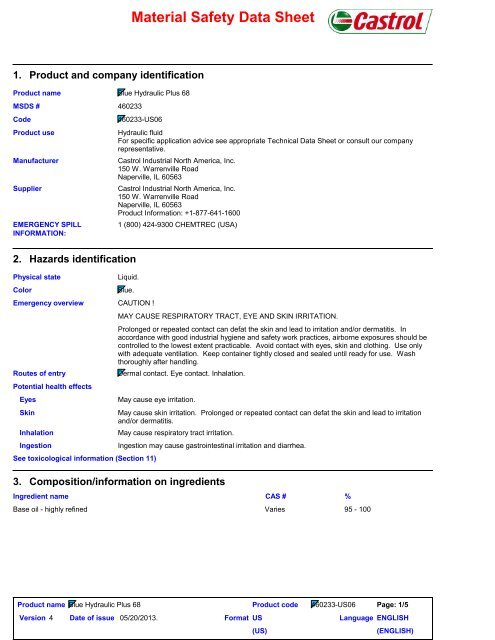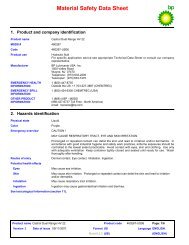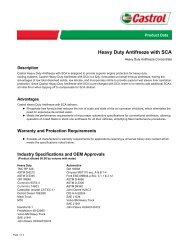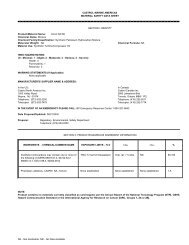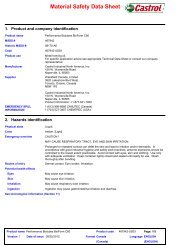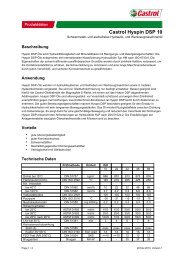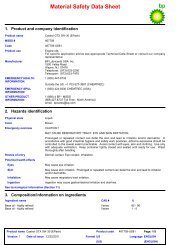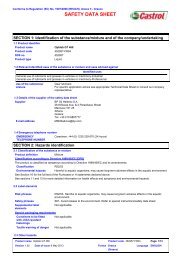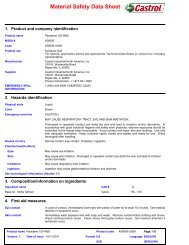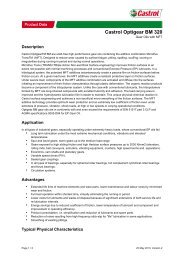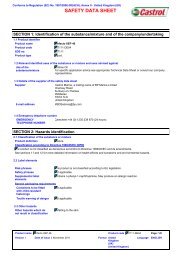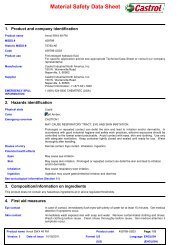(US)213935Blue Hydraulic Plus 68.pdf - Castrol
(US)213935Blue Hydraulic Plus 68.pdf - Castrol
(US)213935Blue Hydraulic Plus 68.pdf - Castrol
- No tags were found...
You also want an ePaper? Increase the reach of your titles
YUMPU automatically turns print PDFs into web optimized ePapers that Google loves.
Material Safety Data Sheet1. Product and company identificationProduct name Blue <strong>Hydraulic</strong> <strong>Plus</strong> 68MSDS # 460233CodeProduct useManufacturerSupplierEMERGENCY SPILLINFORMATION:460233-<strong>US</strong>06<strong>Hydraulic</strong> fluidFor specific application advice see appropriate Technical Data Sheet or consult our companyrepresentative.<strong>Castrol</strong> Industrial North America, Inc.150 W. Warrenville RoadNaperville, IL 60563<strong>Castrol</strong> Industrial North America, Inc.150 W. Warrenville RoadNaperville, IL 60563Product Information: +1-877-641-16001 (800) 424-9300 CHEMTREC (<strong>US</strong>A)2. Hazards identificationPhysical stateColorBlue.Emergency overview CAUTION !Routes of entryPotential health effectsEyesSkinInhalationIngestionLiquid.See toxicological information (Section 11)MAY CA<strong>US</strong>E RESPIRATORY TRACT, EYE AND SKIN IRRITATION.Prolonged or repeated contact can defat the skin and lead to irritation and/or dermatitis. Inaccordance with good industrial hygiene and safety work practices, airborne exposures should becontrolled to the lowest extent practicable. Avoid contact with eyes, skin and clothing. Use onlywith adequate ventilation. Keep container tightly closed and sealed until ready for use. Washthoroughly after handling.Dermal contact. Eye contact. Inhalation.May cause eye irritation.May cause skin irritation. Prolonged or repeated contact can defat the skin and lead to irritationand/or dermatitis.May cause respiratory tract irritation.Ingestion may cause gastrointestinal irritation and diarrhea.3. Composition/information on ingredientsIngredient name CAS # %Base oil - highly refined Varies 95 - 100Product name Blue <strong>Hydraulic</strong> <strong>Plus</strong> 68Product code 460233-<strong>US</strong>06Version 4 Date of issue 05/20/2013.Format <strong>US</strong>Language(<strong>US</strong>)Page: 1/5ENGLISH(ENGLISH)
4. First aid measuresEye contactSkin contactInhalationIngestionNotes to physicianIn case of contact, immediately flush eyes with plenty of water for at least 15 minutes. Getmedical attention if symptoms occur.Immediately wash exposed skin with soap and water. Remove contaminated clothing and shoes.Wash clothing before reuse. Clean shoes thoroughly before reuse. Get medical attention ifsymptoms occur.If inhaled, remove to fresh air. Get medical attention if symptoms occur.Do not induce vomiting unless directed to do so by medical personnel. Never give anything bymouth to an unconscious person. If potentially dangerous quantities of this material have beenswallowed, call a physician immediately. Get medical attention if symptoms occur.Note: High Pressure ApplicationsInjections through the skin resulting from contact with the product at high pressure constitute amajor medical emergency. Injuries may not appear serious at first but within a few hours tissuebecomes swollen, discolored and extremely painful with extensive subcutaneous necrosis.Surgical exploration should be undertaken without delay. Thorough and extensive debridement ofthe wound and underlying tissue is necessary to minimize tissue loss and prevent or limitpermanent damage. Note that high pressure may force the product considerable distances alongtissue planes.5. Fire-fighting measuresFlash pointFire/explosion hazardsExtinguishing mediaSuitableNot suitableFire-fighting proceduresHazardous combustionproductsProtective clothing (fire)Open cup: >195°C (>383°F) [Cleveland.]In a fire or if heated, a pressure increase will occur and the container may burst.Use an extinguishing agent suitable for the surrounding fire.Do not use water jet.Promptly isolate the scene by removing all persons from the vicinity of the incident if there is a fire.No action shall be taken involving any personal risk or without suitable training.Combustion products may include the following:carbon oxides (CO, CO2) (carbon monoxide, carbon dioxide)Fire-fighters should wear appropriate protective equipment and self-contained breathingapparatus (SCBA) with a full face-piece operated in positive pressure mode.6. Accidental release measuresPersonal precautionsEnvironmentalprecautionsMethods for cleaning upLarge spillSmall spillNo action shall be taken involving any personal risk or without suitable training. Keepunnecessary and unprotected personnel from entering. Do not touch or walk through spilledmaterial. In accordance with good industrial hygiene and safety work practices, airborneexposures should be controlled to the lowest extent practicable. Provide adequate ventilation.Wear appropriate respirator when ventilation is inadequate. Put on appropriate personalprotective equipment (see Section 8).Avoid dispersal of spilled material and runoff and contact with soil, waterways, drains and sewers.Inform the relevant authorities if the product has caused environmental pollution (sewers,waterways, soil or air).Stop leak if without risk. Move containers from spill area. Approach release from upwind.Prevent entry into sewers, water courses, basements or confined areas. Wash spillages into aneffluent treatment plant or proceed as follows. Contain and collect spillage with non-combustible,absorbent material e.g. sand, earth, vermiculite or diatomaceous earth and place in container fordisposal according to local regulations (see Section 13). Dispose of via a licensed waste disposalcontractor. Contaminated absorbent material may pose the same hazard as the spilled product.Note: see Section 1 for emergency contact information and Section 13 for waste disposal.Stop leak if without risk. Move containers from spill area. Dilute with water and mop up if watersoluble.Alternatively, or if water-insoluble, absorb with an inert dry material and place in anappropriate waste disposal container. Dispose of via a licensed waste disposal contractor.Product name Blue <strong>Hydraulic</strong> <strong>Plus</strong> 68Product code 460233-<strong>US</strong>06Version 4 Date of issue 05/20/2013.Format <strong>US</strong>Language(<strong>US</strong>)Page: 2/5ENGLISH(ENGLISH)
7. Handling and storageHandlingStoragePut on appropriate personal protective equipment (see Section 8). Workers should wash handsand face before eating, drinking and smoking. Do not breathe vapor or mist. Do not ingest.Avoid contact with eyes, skin and clothing. Use only with adequate ventilation. Wear appropriaterespirator when ventilation is inadequate.Store in accordance with local regulations. Store away from direct sunlight in a dry, cool and wellventilatedarea, away from incompatible materials (see Section 10). Keep container tightly closedand sealed until ready for use. Containers that have been opened must be carefully resealed andkept upright to prevent leakage. Do not store in unlabeled containers. Use appropriatecontainment to avoid environmental contamination.8. Exposure controls/personal protectionOccupational exposure limitsIngredient nameBase oil - highly refinedSome states may enforce more stringent exposure limits.Occupational exposure limitsACGIH TLV (United States).TWA: 5 mg/m³ 8 hours. Issued/Revised: 11/2009 Form: Inhalable fractionNIOSH REL (United States).TWA: 5 mg/m³ 10 hours. Issued/Revised: 6/1994 Form: MistSTEL: 10 mg/m³ 15 minutes. Issued/Revised: 6/1994 Form: MistOSHA PEL (United States).TWA: 5 mg/m³ 8 hours. Issued/Revised: 6/1993While specific OELs for certain components may be shown in this section, other components may be present in any mist, vapor ordust produced. Therefore, the specific OELs may not be applicable to the product as a whole and are provided for guidance only.Control MeasuresHygiene measuresPersonal protectionEyesSkin and bodyRespiratoryHandsUse only with adequate ventilation. If user operations generate dust, fumes, gas, vapor or mist,use process enclosures, local exhaust ventilation or other engineering controls to keep workerexposure to airborne contaminants below any recommended or statutory limits.Wash hands, forearms and face thoroughly after handling chemical products, before eating,smoking and using the lavatory and at the end of the working period. Appropriate techniquesshould be used to remove potentially contaminated clothing. Wash contaminated clothing beforereusing.Avoid contact with eyes. Safety glasses with side shields or chemical goggles.Avoid contact with skin and clothing. Wear suitable protective clothing.Use adequate ventilation. In accordance with good industrial hygiene and safety work practices,airborne exposures should be controlled to the lowest extent practicable.The correct choice of protective gloves depends upon the chemicals being handled, the conditionsof work and use, and the condition of the gloves (even the best chemically resistant glove willbreak down after repeated chemical exposures). Most gloves provide only a short time ofprotection before they must be discarded and replaced. Because specific work environments andmaterial handling practices vary, safety procedures should be developed for each intendedapplication. Gloves should therefore be chosen in consultation with the supplier/manufacturer andwith a full assessment of the working conditions.9.Physical and chemical propertiesPhysical stateColorFlash pointDensityLiquid.Blue.Open cup: >195°C (>383°F) [Cleveland.]879 kg/m³ (0.879 g/cm³) at 15°CViscosity Kinematic: 64.6 to 71.4 mm 2 /s (64.6 to 71.4 cSt) at 40°CKinematic: 8.7 mm 2 /s (8.7 cSt) at 100°CSolubilityinsoluble in water.Product name Blue <strong>Hydraulic</strong> <strong>Plus</strong> 68Product code 460233-<strong>US</strong>06Version 4 Date of issue 05/20/2013.Format <strong>US</strong>Language(<strong>US</strong>)Page: 3/5ENGLISH(ENGLISH)
10. Stability and reactivityStability and reactivityPossibility of hazardousreactionsConditions to avoidIncompatibility withvarious substancesHazardous decompositionproductsHazardous polymerizationThe product is stable.Under normal conditions of storage and use, hazardous reactions will not occur.Avoid all possible sources of ignition (spark or flame).Reactive or incompatible with the following materials: oxidizing materials.Under normal conditions of storage and use, hazardous decomposition products should not beproduced.Under normal conditions of storage and use, hazardous polymerization will not occur.11. Toxicological informationPotential chronic health effectsCarcinogenicityNo known significant effects or critical hazards.12. Ecological informationEcotoxicityNo testing has been performed by the manufacturer.13. Disposal considerationsWaste informationThe generation of waste should be avoided or minimized wherever possible. Disposal of thisproduct, solutions and any by-products should at all times comply with the requirements ofenvironmental protection and waste disposal legislation and any regional local authorityrequirements. Dispose of surplus and non-recyclable products via a licensed waste disposalcontractor. Waste should not be disposed of untreated to the sewer unless fully compliant withthe requirements of all authorities with jurisdiction. Waste packaging should be recycled.Incineration or landfill should only be considered when recycling is not feasible. This material andits container must be disposed of in a safe way. Care should be taken when handling emptiedcontainers that have not been cleaned or rinsed out. Empty containers or liners may retain someproduct residues. Avoid dispersal of spilled material and runoff and contact with soil, waterways,drains and sewers.NOTE: The generator of waste has the responsibility for proper waste identification (based on characteristic(s) or listing),transportation and disposal14. Transport informationNot classified as hazardous for transport (DOT, TDG, IMO/IMDG, IATA/ICAO)15. Regulatory informationU.S. Federal RegulationsUnited States inventory(TSCA 8b)All components are listed or exempted.SARA 302/304: No products were found.SARA 311/312 Hazards identification: Immediate (acute) health hazardSARA 313Form R - ReportingrequirementsSupplier notificationThis product does not contain any hazardous ingredients at or above regulated thresholds.This product does not contain any hazardous ingredients at or above regulated thresholds.Product name Blue <strong>Hydraulic</strong> <strong>Plus</strong> 68Product code 460233-<strong>US</strong>06Version 4 Date of issue 05/20/2013.Format <strong>US</strong>Language(<strong>US</strong>)Page: 4/5ENGLISH(ENGLISH)
CERCLA Sections102a/103 HazardousSubstances (40 CFRPart 302.4):State regulationsMassachusettsSubstancesNew Jersey HazardousSubstancesPennsylvania RTKHazardous SubstancesCalifornia Prop. 65Other regulationsCanada inventoryREACH StatusAustralia inventory (AICS)China inventory (IECSC)Japan inventory (ENCS)Korea inventory (KECI)Philippines inventory(PICCS)CERCLA: Hazardous substances.: Zinc dialkyl dithiophosphate; Ethyl acrylate: 1000 lbs. (454 kg);xylene: 100 lbs. (45.4 kg); Ethylbenzene: 1000 lbs. (454 kg);None of the components are listed.The following components are listed: MINERAL OIL (UNTREATED and MILDLY TREATED)None of the components are listed.WARNING: This product contains a chemical known to the State of California to cause cancer.Ethylbenzene; Ethyl acrylateAll components are listed or exempted.For the REACH status of this product please consult your company contact, as identified inSection 1.All components are listed or exempted.All components are listed or exempted.At least one component is not listed.All components are listed or exempted.All components are listed or exempted.16. Other informationLabel requirements CAUTION !MAY CA<strong>US</strong>E RESPIRATORY TRACT, EYE AND SKIN IRRITATION.HMIS® Rating :HistoryDate of issueDate of previous issuePrepared byNotice to readerHealth 1Flammability 1Physical 0HazardPersonal Bprotection05/20/2013.06/30/2009.Product StewardshipIndicates information that has changed from previously issued version.National Fire1ProtectionFire hazardAssociation (U.S.A.) Health 1 0 InstabilitySpecific hazardAll reasonably practicable steps have been taken to ensure this data sheet and the health, safety and environmental informationcontained in it is accurate as of the date specified below. No warranty or representation, express or implied is made as to theaccuracy or completeness of the data and information in this data sheet.The data and advice given apply when the product is sold for the stated application or applications. You should not use the productother than for the stated application or applications without seeking advice from BP Group.It is the user’s obligation to evaluate and use this product safely and to comply with all applicable laws and regulations. The BPGroup shall not be responsible for any damage or injury resulting from use, other than the stated product use of the material, fromany failure to adhere to recommendations, or from any hazards inherent in the nature of the material. Purchasers of the product forsupply to a third party for use at work, have a duty to take all necessary steps to ensure that any person handling or using theproduct is provided with the information in this sheet. Employers have a duty to tell employees and others who may be affected ofany hazards described in this sheet and of any precautions that should be taken. You can contact the BP Group to ensure that thisdocument is the most current available. Alteration of this document is strictly prohibited.Product name Blue <strong>Hydraulic</strong> <strong>Plus</strong> 68Product code 460233-<strong>US</strong>06Version 4 Date of issue 05/20/2013.Format <strong>US</strong>Language(<strong>US</strong>)Page: 5/5ENGLISH(ENGLISH)


